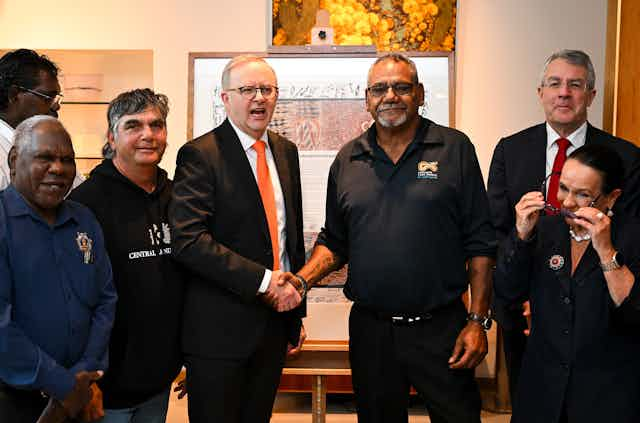Aboriginal and Torres Strait Islander readers are advised this article contains names of deceased people.
This week at Parliament House during Barunga Festival, four NT Land Council representatives presented Prime Minister Anthony Albanese with the Barunga Declaration.
Signed by the four NT Land Council representatives, the declaration calls on Australians to vote “yes” in the upcoming referendum for an Indigenous Voice to Parliament.
NT Land Council representatives Dr Samuel Bush-Blanasi (Northern Land Council), Matthew Palmer (Central Land Council), Gibson Farmer Illortaminni (Tiwi Land Council) and Thomas Amagula (Anindilyakwa Land Council) brought the Barunga Declaration to Parliament House.
This is significant because the leaders of the Central and Northern land councils, artist Wenten Rubunjta and activist Galarrwuy Yunupingu presented then prime minister Bob Hawke with the Barunga Statement in 1988. The statement called on Hawke to honour his earlier promises to deliver national land rights legislation and a treaty.
Hawke signed the statement and promised a treaty by 1990.
Treaty ’88 and the Barunga Statement
The Barunga Statement was the outcome of years of careful deliberation and discussion. Its presentation was carefully designed to capture symbols and painted representations significant to both desert and saltwater people. It was delivered from “the Indigenous owners and occupiers of Australia”, requesting the Australian government legislate for national land rights and begin treaty negotiations.
The statement also demanded compensation for land loss, protection of sacred sites, the return of ancestral remains, linguistic and cultural rights, and the rights enshrined in the UN Declaration of Human Rights. It also called for laws for a national elected Aboriginal body, and recognition of customary law by police and justice systems. It concluded by urging the Australian government to support international law-making upholding the rights of Indigenous peoples.
The Barunga Statement was presented during a time where there were increasing calls for a treaty. The Treaty ’88 campaign declared that Australia was invaded by a foreign power with no treaty. As Wiradjuri activist and writer Kevin Gilbert argued, in Australia, “the thief is the judge”.
In the 1970s, there were two major legal challenges – the Gove land rights judgement and the 1979 Coe case. These cases had reinscribed terra nullius by rejecting Indigenous peoples rights to land that existed outside the norms of European landholding. They ultimately denied Indigenous sovereignty to uphold Australian settler rights to land.
Fast forward to 1988, and Hawke’s government poured billions into the bicentenary celebrations (or a “birthday for white people”, as activist and Palawa man Michael Mansell called it). The opening to Hawke’s “celebration of the nation” was an Australia Day event in Sydney Harbour, featuring a re-enactment of the First Fleet.
This was met by protest “Don’t Celebrate ‘88”, led by Aboriginal and Torres Strait Islander people from across the continent. The protest began at dawn, and ran into the night.
The demand for a treaty had been gaining momentum since the National Aboriginal Conference called for a Makarrata, a Yolngu word referring to the negotiation of peace after a dispute, in 1979. But in 1983, a Senate committee rejected the idea that Aboriginal and Torres Strait Islander people had sovereignty and could enter into a treaty with Australia.
Shortly after, Hawke dismantled the National Aboriginal Conference. A national land rights response was developed, but a poorly conceived draft proposal from Hawke was rejected by Aboriginal Land Councils in 1984.
Read more: What actually is a treaty? What could it mean for Indigenous people?
‘Treaty by 1990’
Hawke progressed the Council for Aboriginal Reconciliation, a 25-member group charged with the task of raising awareness in the general public of Aboriginal and Torres Strait Island cultures and history.
This council achieved significant traction over the next decade, leading to the walk for reconciliation in 2000, which still stands as a moment demonstrating significant national sentiment in support of Indigenous rights.
However, others have highlighted the reconciliation movement’s departure from treaty. Playwright Wesley Enoch and actress Deborah Mailman’s play 7 Stages of Grieving includes a poem emphasising instead the “wreck”, “con” and “silly” in reconciliation.
Hawke’s last official act as Prime Minister was to hang the Barunga Statement in Parliament House. Even though by 1991 little progress had been made towards the statement’s goals. The idea of a treaty had largely been replaced with the notion of “reconciliation”.
In 2006, Yunupingu called for the return of the Barunga Statement to Barunga. Yunupingu said governments had betrayed reconciliation, and he called for the statement to be traditionally buried. This would symbolise the burial of hopes for a treaty, saying
Sovereignty became treaty, treaty became reconciliation and reconciliation turned into nothing.
The Statement remains in Parliament House, despite Yunupingu’s request.
To properly consider the Voice, we need to look to how we got here
Critics of the Voice to Parliament often choose to focus on First Nations peoples’ struggles, the repeated experience of disadvantage – the persistent “gap”.
However, the Voice aims to address a key problem that recreates disadvantage: First Nations’ political power. First Nations peoples have long sought representation to seek particular rights to land, culture and heritage, language, self-determination and self-governance.
As with the Uluru Statement from the Heart and now the Barunga Declaration, the Barunga Statement emerged during a time when Indigenous activists were seeking new mechanisms to secure a lasting political settlement between Indigenous nations and the Australian government.
The referendum for a Voice is the first of a three-part sequence of reforms, outlined in the 2017 Uluru Statement, followed by treaty and truth-telling. Some states and territory governments are already advancing their own treaty processes or agreement-making processes.
The Barunga Statement experience tells us that political relations between Australian and Indigenous people can bring rising hope, optimism and near always disappointment as political will wanes.
The Uluru Statement from the Heart and the Barunga Declaration both demonstrate enduring aspirations for a worthwhile and meaningful political agreement between Indigenous people and government.

